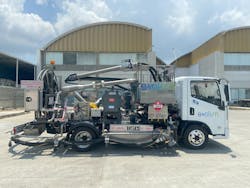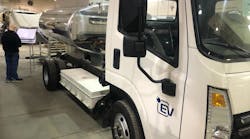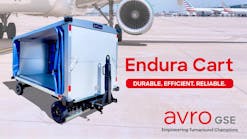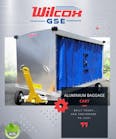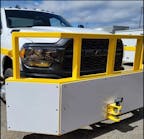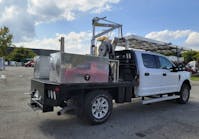With environmental initiatives influencing the ground handling industry, more fueling service providers are seeking ways to reduce carbon emissions while working on the ramp.
To assist ground handlers with this mission, Garsite offers electric versions of its hydrant dispenser vehicles.
As electric units, the hydrant dispensers operate very similarly to standard internal combustion engine (ICE) vehicles, which allows for easier integration into existing fleets, explains Terry Bosserman, chief commercial officer for Garsite. However, users realize benefits such as reduced emissions and less noise by using the electric version.
“The majority of our customers are looking for reliability and good battery life,” Bosserman points out. “Ultimately, they want a unit that operates as similar as possible to their internal combustion engine (ICE) vehicles.”
Garsite has supplied its Electric Hydrant Dispensers since 1999. Bosserman says the company prides itself on staying at the global forefront of aircraft refueling equipment design and manufacturing. Hence, the electric vehicle was designed to support the industry’s efforts to lower its carbon footprint.
Company officials note the hydrant dispenser offers a fully self-contained and maintenance-free pressure control system, which does not require an external air source, electrical source or nitrogen source. Additionally, the all-aluminum deck and hose reel reduces maintenance requirements.
The Electric Hydrant Dispenser utilizes a lithium ferrophosphate (LFP) battery, which requires 240 volt, 40 amp charging.
“We offer several chassis options and flow rates, ranging from 450 gallons per minute (GPM), or 1,700 liters per minute (LPM), to 1,000 GPM, or 3,800 LPM,” Bosserman says. “We also offer a mini dispenser with a fixed fueling platform, in addition to our standard wide-body units.”
Garsite’s multiple chassis options includes a cost-effective narrow-body unit built on a Charlatte electric tractor.
“We have made many chassis advancements since we first launched our electric units in 1999, with the largest being improvements to the battery packs and battery management,” Bosserman says. “Charging solutions have greatly improved as well. We continue to monitor chassis advancements and look for ways to further improve our electric designs.”
Garsite’s Electric Hydrant Dispensers support fueling for all series of aircraft up to the Boeing 777-9 and Airbus A380.
And with an integrated solar-powered system, additional benefits can be achieved.
“The integrated solar-powered system helps isolate the electrical requirements for the pumping system and extends the life of the battery pack between charges,” Bosserman says.
Additional standard features include hydrant coupler, filter/monitor, deadman control, pressure controls, meter, single wrap fueling hose reel, fueling hose, underwing nozzle, wrap-around style inlet hose, product recovery tank and aluminum piping.
Compliant with all NFPA 407 codes and ATA-103 requirements, the hydrant dispensers include safety features such as a manual rewind static reel with a 50-foot cable and clip, a brake interlock system, emergency shut down system and a fire extinguisher.
Currently Garsite has units in operations in multiple locations across the United States, Canada, South America, the Caribbean and Southeast Asia. Feeback from these customers has been positive, according to Bosserman.
“The electric units offer reliable operation and lower maintenance costs, compared to an internal combustion engine unit,” he says. “Many customers have had to develop new policies for stationing and charging the vehicles as well as working with their local fire marshal to ensure policies are developed for daily operation.”
To select fueling equipment appropriately for a given operation, Bosserman recommends specifying component brands, registration and connectivity features, flow rate, fueling platform type, and position when making a purchasing decision.
“Consider driving conditions, range and charging options when deciding between electric and internal combustion engine vehicles,” Bosserman adds. “For the fueling system, consider local regulations and standards, aircraft types to be serviced and personnel familiarity.”
What’s more, extreme cold and hot weather can affect battery performance without the proper modifications, Bosserman advises.
“Electric chassis units will require downtime for charging, so you must look at flight schedules and travel distance to ensure electric units work for your operation.”
To keep units in good working conditions, regular preventative maintenance (PM) schedules and inspections should be adhered to, in addition to battery charging.
“Selecting the proper equipment can lower maintenance costs, reduce equipment downtime and, over time, make fueling operations more efficient and profitable,” Bosserman concludes.
